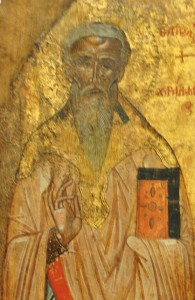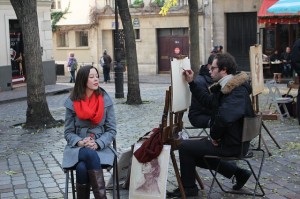
We Christians proclaim “the gospel.” The word means “good news.” What happens when what we tell the world sounds old and worn — not “news” at all. Worse still, what happens when what we say doesn’t actually sound “good” to people? Sometimes looking away from our tracts and truisms, looking back to what Christians used to say about Jesus can be like a cool breeze in a stuffy closed house.
Today is the commemoration of one of my favorite thinkers in all of Christian history: St. Athanasius of Alexandria (c. 297-373). There’s a guy whose old teaching is good news today.
For a very long time in Western Christianity we have tended to focus on sin as a legal problem: sin is a crime, a law broken which a just God is obliged to punish. This sense of the problem predisposes us to focus on the legal aspects of God’s solution — Christ’s sacrifice on the Cross as a satisfaction of the problems of divine justice.
There is a great deal of biblical truth to that sense of the story — even if it did not become so dominant until the Middle Ages.
One problem, though, is that this telling of the gospel has been said, and written, and packaged and repackaged until in a sense it is not “news.”
Another problem is that for many today it doesn’t actually sound “good.” People have a hard time seeing their own behavior as breaking a law subject to the death penalty. We end up having to convince people that they have a problem they don’t feel so that we can present them with Jesus as the solution.
That is, no matter how true, we have to spend our energy convincing people of the bad news so that the gospel can make sense.
Athanasius doesn’t start by looking at the Cross. Athanasius starts with the amazing fact that in Jesus Christ the eternal God became human. Check out his classic work On the Incarnation.
Here’s the short version:
We were created in the image of God, intended to live forever in communion with God, gazing toward God and moving toward God and becoming ever more like God.
Humanity sinned — but instead of thinking about disobedience and crime, think of human beings turning away from God and moving the opposite direction.
Moving toward God is life. Moving away from God is death.
Athanasius calls the problem “corruption” but he isn’t thinking of politicians taking bribes. Corruption is what happens when we die.
When we are alive all our systems are functioning and all our parts stay together. Once we die we don’t function. Our bodies fall apart. We decay. That is why we bury dead bodies — because what was a highly organized living being is, slowly or quickly, going to become soil again.
That loss of life, death and decay is, for Athanasius, the fundamental problem. We were intended to live and thrive and express the image of God. It is a horrible tragedy that something God made so good should fall into corruption and non-existence.
Enter Jesus Christ.

Athanasius describes how Jesus Christ being born is the essential move in the process of our salvation:
Imagine God the Father as a painter. God the Son is the spitting image of his Father. The Father has the Son, the Word, sit to have his portrait painted — and we human beings are that portrait.
The Son IS the image of God. We are IN the image of God — like a painting is different from, but similar to, the one who sat before the artist.
Then the painting got ruined — smeared and smudged by sin we just don’t look like the image of God any more.
God doesn’t trash the painting. God restores the painting — through Jesus.
The Son comes to sit before the artist once again, so that we can be restored as God’s painting. When Jesus comes, the Image of God is restored in humanity.
So if you are still with me, here’s the deal: people today can make good sense of Athanasius’ sense of the human problem. We know what it means to say we have turned away from God; we’re used to pursuing everything but God. We know what it means to have any similarity to God’s image in our lives ruined; think of abuse, addiction, apathy, arrogance — and in the dictionary of death-dealing things that is just the start of the “A” section.
Athanasius diagnoses our problem. Turning from the God who is life we find death. Our careers may thrive but our lives fail.
Athanasius presents Jesus as a solution who makes sense. When we had fallen apart, and were aiming toward death, Jesus, the very Image of God came and began to restore us. Instead of chaos and decay, in him we see clarity, unity, life itself gushing from its Source.
Joined to Jesus by faith we too move toward restoration — and hand in hand our lives turn toward God in the journey of a lifetime.
————
P.S. I hope you’ll subscribe for regular updates — I post about twice a week bringing historical Christianity into conversation with today’s culture.
Gary Neal Hansen
————
I’d love to hear from you in the comments: How would you describe the central human problem? How are today’s Christians doing at proclaiming Christ as a solution that is both “good” and “news”?
Click here to see more posts on role models for today’s Christians (aka “Saints”!)

Thanks Gary.
“Another problem is that for many today it doesn’t actually sound “good.” People have a hard time seeing their own behavior as breaking a law subject to the death penalty. We end up having to convince people that they have a problem they don’t feel so that we can present them with Jesus as the solution.”
I feel like I run into this dilemma a lot.
I really like knowing there is another way to speak of our short-fall and God’s amazing love. I’ll have to check out Athanasius more closely!!
Appreciate your blog!
Al
Thanks so much, Al!
The translation I’ve most enjoyed used to be in the SVS Press “Popular Patristics” series with the translator listed as “A Religious of the C.S.M.V.”, apparently Penelope Lawson. That one can be found on Kindle still. The same publisher has a new translation out now which you can check out here:
http://www.amazon.com/Incarnation-Saint-Athanasius-Popular-Patristics/dp/0881414271/ref=sr_1_4?s=books&ie=UTF8&qid=1399056761&sr=1-4&keywords=on+the+incarnation
One great thing about the paper edition is a classic preface by C.S. Lewis on the value of old writers of old books.
Enjoy!
I think the central human problem is that many individuals don’t know God’s infinite unconditional love for them, perhaps because they don’t think themselves worthy of love and don’t really love themselves. One can’t respond to love that one doesn’t experience or even know exists.. I thank God often for that love God has for me, am in awe at the “unconditionalness” of that love, pray to really love myself, and pray that the world will experience God’s love and respond to it by love of God and love of all humans and all of God’s creation.
Thank you Sr. Mary Ann! Wise words. I’ll join you in that prayer. And do stop by again soon, okay?
Another wonderful post. Thank you!
However, you left out St. Athanasius’ most famous quote! “Αυτος γαρ ενηνθρωπησεν, ινα ημεις θεοποιηθωμεν,” which is translated in Fr. John Behr’s translation as, “For he was incarnate that we might be made god” (On the Incarnation, 54). Some translate it as, “God became man so that we might become god/divine.”
Of course, there were many other Patristic Fathers who also said this: St. Irenaeus of Lyon (Against Heresies, bk. 5, preface), St. Clement of Alexandria (Exhortation to the Greeks, 1), St. Justin the Martyr (Dialogue with Trypho, 124), St. Hippolytus of Rome (Refutation of all Heresies, Book X, Chapter 30), St. Gregory of Nyssa (On Christian Perfection), St. Basil of Caesarea (On the Spirit 9.23), St. Gregory of Nazianzus (Orations 30.14), and, later, St. Maximus of the Confessor (Ambiguum 7), and even St. Augustin of Hippo (On the Psalms, 50.2).
The reality of Christ being Incarnate (enfleshed) sparks our recreation, or transformation, or transfiguration, which is completed in the resurrection. It is this aspect of theology that has led the Orthodox Church to ask at baptism, not whether you “accept Christ?” but rather, have you “united yourself to Christ?”
Of course the reality of the Incarnation, and the cosmic renewal sparked by Christ’s enfleshment is the foundation for the 2,000 year old theology of Christian sacraments. They are much more than symbols. They are truly a presence of both the natural and spiritual, and, as such, it is through the sacraments that the grace of God is communicated, just as God used material means for the Incarnation and union of humanity with divinity.
I liked your image of a portrait, very nice. Another image I like is that of yeast (forgive me, I don’t remember where I got this image). Christ is like yeast in bread. Just as the yeast affects the entire loaf, causing it to rise, so too does Christ’s enfleshment affect all of humanity, causing us to rise.